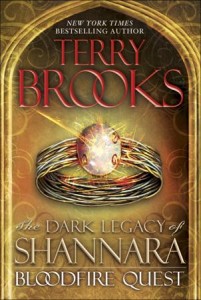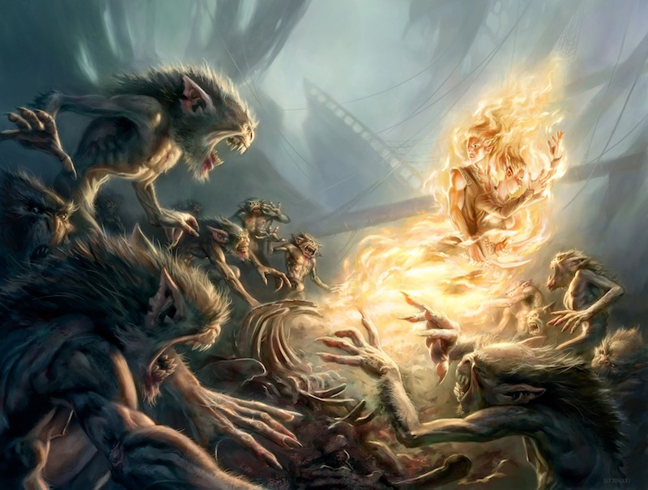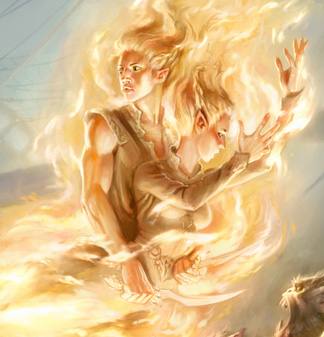
In recent years, I’ve reviewed several novels by Terry Brooks, most of which I walked away from with disappointment and uncomfortable acceptance. Slowly, with each new release, I was beginning to understand that Brooks, an idol of my adolesence, just wasn’t the same author I grew up with. This isn’t a comment on his skill, or his prose ability, necessarily, but rather an observation about the stories he now chooses to tell. His early novels were doorstops and told a complete story arc from beginning to end. After his third novel, however, he began to split these novels into ‘trilogies,’ and release them on a yearly basis. There’s little less satisfying than picking up a new book from a favourite author and being left hanging, asked to wait politely for a year and then pony up another $25 to continue with the fun. Whether it was marketing malfeasance on the part of his publisher, or a conscious decision by Brooks, excitement was slowly replaced by… not apathy, exactly, but controlled optimism. Brooks was on a treadmill.
Then I read Wards of Faerie (REVIEW), the first volume in his The Dark Legacy of Shannara trilogy, and, like the clouds parting over the Battle of Pelennor Fields, I was suddenly heartened and reminded of why I first fell in love with Brooks’ novels as a teenager.
Of Wards of Faerie, I wrote:
It was meatier, slower paced and the characters had real motivations, real depth to them that reminded me of his earlier works. Aphenglow Ellessedil might not have been as immediately engaging as Wil Ohmsford or as mysterious as Walker Boh, but there was an inner drive to her quest to find the missing Elfstones that delved deep than my-valley-is-at-risk, or the-bad-guys-are-coming. It was curiousity, it spoke of adventure and promised of new lands to explore. These elements have been scattered throughout Brooks’ more recent works, but they felt more concentrated here, purer. The pages started turning and I finished Wards of Faerie in about a third the amount of time that it took me to finish Brooks’ last novel, The Measure of Magic. I couldn’t put it down.
The same praise applies to its sequel, Bloodfire Quest, though, even moreso than Wards of Faerie, this is a book aimed specifically at Brooks’ already-in-place legion of fans. And, perhaps just as important its success, each volume of the trilogy is set for release just six month after the previous, meaning readers will finish the entire trilogy in the same span of time as they’d usually wait for one novel from Brooks.

By virtue of existing, Bloodfire Quest and The Dark Legacy of Shannara makes one of Brooks’ lesser works retroactively stronger.
Bloodfire Quest is at once a direct sequel to The Elfstones of Shannara and an ending for The High Druid of Shannara. One of the major complaints levelled at The High Druid of Shannara, the most previous of Brooks’ trilogies in terms of series timeline, is that while it was ostensibly a self-contained set of books, several of the plotlines, including the majority of Grianne’s struggles against the Jarka Ruus, were left unresolved, leaving readers feeling unsatisfied. It was unusual for Brooks fans, who are used to his previous history of nicely wrapping up the significant plotlines by the time the final book was over. The Dark Legacy of Shannara, and Bloodfire Quest in particular, is the continuation of the story that began in The High Druid of Shannara and it was unfair of Brooks to leave readers hanging for so long, writing several pre-Shannara novels and a Landover novel, before giving them the ending they’ve been waiting for. When all is said and done, I expect that this series will be inseparable from The High Druid of Shannara, considered a six-volume-long set, rather than two separate trilogies. By virtue of existing, Bloodfire Quest and The Dark Legacy of Shannara makes one of Brooks’ lesser works retroactively stronger.
War serves as a backdrop for many of Brooks’ novels, most notably in The Sword of Shannara and The Heritage of Shannara, but world-conquering antagonists and kingdom-shaking armies have taken a back seat to more personal stories in his recent works, such as The Voyage of the Jerle Shannara and the maligned High Druid of Shannara trilogies. Bloodfire Quest falls firmly into this second category, sticking tightly to the stories of the same protagonists readers met in Wards of Faerie and keeping the scale of its action small and frenetic. If Brooks continues to push the intertwining plotlines in the direction they appear to be moving, however, it’s easy to imagine that the final volume, Witch Wraith will feature one of the largest military battles that the series has ever seen. Brooks recently suggested that an end to the Shannara series is closer than fans realized, and this end hinges on the ultimate confrontation between the forces of magic and science, to decide the future of the Four Lands while, hopefully, avoid repeating the mistakes that caused the destruction of the Old World, thousands of years earlier. In one passage, Brooks makes clear that the first skirmishes of that war are now happening, with all-out warfare on the horizon:
She took a moment to consider the possibility, a dark forewarning of something she had thought about before. The Druids had feared for some time now that diapason weapons even more destructive and dangerous than those already employed by the Federation were on the horizon. How could it not happen, with the Races and governments of the Four Lands constantly at war, each seeking a way to gain the upper hand? A confrontation between those who cultivated and employed magic, mostly Elves, and those who embraced science, mostly Men, was inevitable. She did not know what form that confrontation between past and present would take, and did not think she would be there to see it, but it would come.
This exploration of the dichotomy (and eerie similarities) between magic and science is one of the strongest aspects of Brooks’ storytelling and he continues to tackle it in a head-on manner that separates his work from the rest of the traditional Epic Fantasy field. Fantasy is often rightly criticized for the static nature of its world building, featuring countries and continents with histories that reach back thousands of years, but show little-to-no technological advancement between the various time periods. Brooks is a breath of fresh air here, though one could wish that he would include societal and cultural advancements similar to those technological changes. The Elves in The Sword of Shannara are little different than the elves in Bloodfire Quest, and that’s a shame.
 One of these technological advancements, which originally seemed a strength of the series, and a sign of Brooks’ innovation (*gasp* Terry Brooks and ‘innovation’ in the same sentence? What have I done?), are the airships. Introduced in The Voyage of the Jerle Shannara, in which they played an integral role in structuring and providing the plot for the trilogy, they have since become somewhat tired and make for awkward positional transitions for the characters as they move quickly throughout the Four Lands. Their ability to allow both the protagonists and antagonists to hop from location-to-location with relative ease has sapped away the sense of journey that was so strong in Brooks’ earlier works. It’s a small complaint, and breaks the series away from the travelogue cliche that brings down so many Epic Fantasy novels, but it also has a tendency to make the novel feel sometime like a stage play, complete with set changes between chapters.
One of these technological advancements, which originally seemed a strength of the series, and a sign of Brooks’ innovation (*gasp* Terry Brooks and ‘innovation’ in the same sentence? What have I done?), are the airships. Introduced in The Voyage of the Jerle Shannara, in which they played an integral role in structuring and providing the plot for the trilogy, they have since become somewhat tired and make for awkward positional transitions for the characters as they move quickly throughout the Four Lands. Their ability to allow both the protagonists and antagonists to hop from location-to-location with relative ease has sapped away the sense of journey that was so strong in Brooks’ earlier works. It’s a small complaint, and breaks the series away from the travelogue cliche that brings down so many Epic Fantasy novels, but it also has a tendency to make the novel feel sometime like a stage play, complete with set changes between chapters.
Bloodfire Quest is full of women who are intelligent, proactive and as fiercely competent (or more) than any of the male characters.
Brooks has always been adept at writing female characters who are equally as strong and important as any of his male characters. It’s a trait that he doesn’t get enough credit for, and Bloodfire Quest is full of women who are as intelligent, proactive and as fiercely competent as any of the male characters. Brooks rarely writes women who need men to overcome their challenges, and Mirai Leah is an example of a capable woman who provides strength and guidance, despite her own fears and challenges, to a young man. The effort of Khyber Elessedil, lost with a young Redden Ohmsford in the inhospitable lands of the Forbidding, shows another sort of strength as she opposes the demonic forces that threaten the Four Lands. Coupled together, there is an interesting duality between the relationships of Aphenglow and Cymrian, and Mirai Leah and Railing Ohmsford. Though separated by many miles in this novel, these two couples deal with finding strength within both themselves and their significant others.
As Bloodfire Quest continues the story begun in Wards of Faerie, the pace begins to accelerate and nearly every page is filled with tension and passionate storytelling. While there is no real beginning or end to the novel, and the ‘Bloodfire Quest’ barely begins by the time the final page is turned, leaving readers with a slightly anti-climatic feeling, it is a satisfying novel and takes Brooks’ characters in interesting directions, even if the plot itself feels a little too familiar.
[Bloodfire Quest] might not change your mind about Brooks, but if you’re a fan, you’ll love it.
Bloodfire Quest is a fine follow-up to Wards of Faerie and continues to prove that The Dark Legacy of Shannara is one of the most exciting and satisfying trilogies that Brooks has written in years. Brooks is known for magic, action, traditional Fantasy tropes and a comfortably familiar world, and all those aspects are featured in Bloodfire Quest in spades. It might not change your mind about Brooks, but if you’re a fan, you’ll love it.

With each of these reviews, I’m more and more curious to give this new series a try.
Good stuff. As a long time fan who has grown largely apathetic (if still quite nostalgic) about the relatively recent Brooks’ installments, your enthusiasm has me looking forward to the time when this current cycle is complete and I can dive in it! Luckily, that’s a relatively short wait-time this time around. ;)
Thanks, guys. I’m glad to know that my enthusiasm can have an effect on readers. Brooks is very popular, but among the visible fan community, he seems to have difficulty finding new readers.
@Doug — I genuinely think the release schedule for this trilogy is one of its strong points. Readin them back-to-back, as one long novel, should only enhance the experience even more. I should have a copy of Witch Wraith landing across my desk soon, and I am anticipating it more than I have any of Terry’s books since Antrax.
You better get your ass to reading Witch Wraith. I’m curious if the whole series works for you or not!
I am new to Terry Brooks novels. I am quiet surprised for not finding him earlier (currently 24yo)…I haven’t read any because I have no idea where to start! I don’t want to start from the very beginning as a lot of people have been disappointed in some of the series…Could you please share your absolute favourite series or novels which could serve as my guide?? Anyone?? I would really appreciate it!
Hi Sam,
You’re right that The Sword of Shannara gets a lot of flak for not aging well. If you’re interested in Shannara, I’d suggest starting with Brooks’ second novel, The Elfstones of Shannara. He really grows as a writer with that novel and most fans consider it to be his best work, myself included.